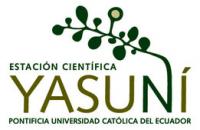

Yasuní
Overview
Yasuní National Park in eastern Ecuador is one of the most biologically diverse areas in the world. In 1995, the Pontificia Universidad Católica de Ecuador (PUCE), the University of Aarhus in Denmark, and ForestGEO-STRI initiated a Forest Dynamics Plot in the northwest portion of the Park in lowland, aseasonal, old-growth rainforest. In 1 ha of the Yasuní FDP, there are 670 tree species. Comparing this number with species counts in 1 ha of forest at other sites—BCI, Panama (168 species); Pasoh, Peninsular Malaysia (497 species)—illustrates the exceptional richness of the Yasuní forest. In the entire 50 ha site we recorded 1,150 species. To date, more than 30 species have been discovered that are new to science.
Trees have been censused once for the entire 50-ha site and four times in the western half of the site, providing demographic data for 25 ha. Ongoing research at the Yasuní FDP includes biweekly monitoring of 200 seed traps, annual censuses of seedlings, and a liana census in part of the site. Annual protocols to evaluate the carbon fluxes are implemented since 2009 and a mortality annual protocol is being incorporated in 2019. Soil structure and nutrient content have been analyzed twice in the western 25 ha of the site.
Longitude: -76.397000000000

